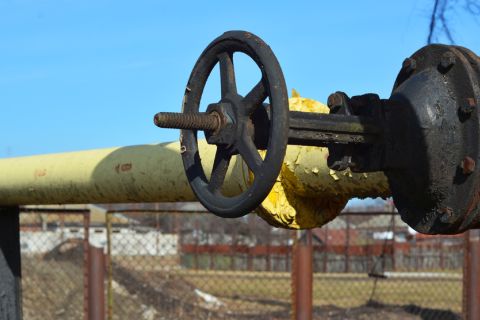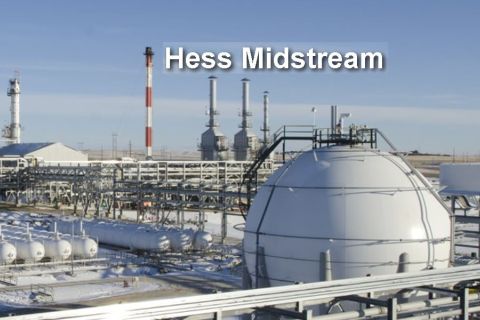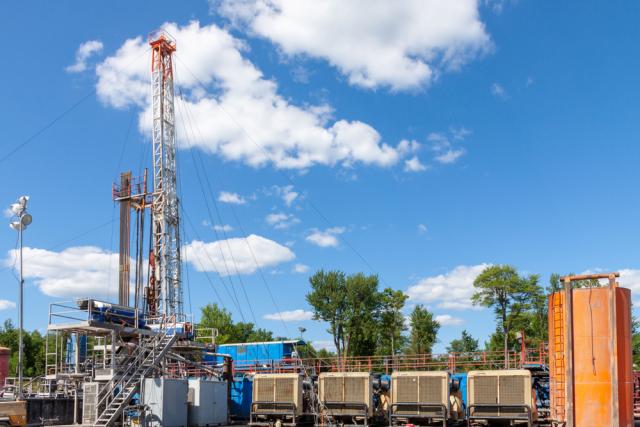
Drilling operations are shown in the Marcellus shale play in rural northern Pennsylvania. (Source: George Sheldon/Shutterstock.com)
PITTSBURGH—If you wanted to quickly summarize the state of the Appalachian region’s natural gas industry listen to what CNX Resources’ COO Tim Dugan and Huntley & Huntley Energy Exploration CEO Chris Doyle had to say at Hart Energy’s DUG East conference and exhibition last week. Every penny counts, they told the audience of more than 1,400 industry professionals.
Producers in the Marcellus and Utica can efficiently drill and complete wells in the core of the region, but the differentiators are takeaway capacity, hedging programs, processing fees and market options, they said.
Mastering Marcellus Margins
Dugan and Doyle, whose company is planning the first hydraulic fracturing well in Murrysville, one of Pittsburgh’s main eastern suburbs, had plenty to offer at the conference. (Look for additional coverage of their Pennsylvania Roundtable coming up on HartEnergy.com) So, too, did PennEnergy Resources CEO Richard Weber, whose company’s efforts have run into challenges primarily due to the explosion on the Revolution Pipeline in Beaver County in September 2018, which caused some of PennEnergy’s production to be shut-in.
“Despite the problems we were having with the Revolution Pipeline, the company still generated EBITDA of about $300 million this year and free cash flow in a range of $20 million,” Weber said. “Unfortunately, the pipeline has cost us about $75 million in EBITDA in 2019. We’ll live, but it is painful.”
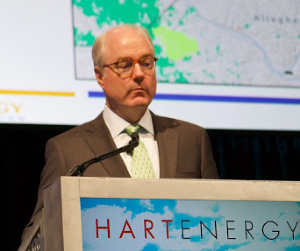
Weber boasted an EBITDA margin per unit of production first-quarter 2019 at $1.73/Mcfe. In 2018, PennEnergy was at about $2.05/Mcfe.
“That puts us at one of the highest margins of any producer in the [Marcellus],” Weber said.
He added PennEnergy, which purchased Rex Energy out of bankruptcy in the fall of 2018 for $600.5 million, is positioned for growth.
“We are making about 500 MMcfe/d. We are running one rig continuously,” Weber said. “We believe we can grow our company between 10% and 15% a year, which is quite remarkable.”
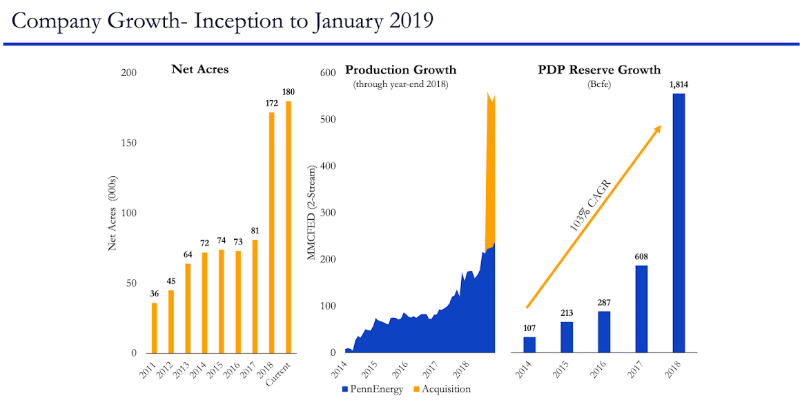
Weber said PennEnergy retains a “very low capital intensity” relative to its peers. Along with a very shallow decline on its wells, he said PennEnergy is able to grow and sustain itself with “relatively modest capital investment.”
He said the company desires to add another rig, which he estimated would grow the company in excess of 20% for many years to come. But, he stressed, the company won’t pull the trigger until “we get the balance sheet to exactly where we want it.”
As for PennEnergy’s success in the Marcellus, Weber said, “key to our company is generating high returns. The average well that we drill is about a 2.6 Bcfe per 1,000-ft lateral.” He said costs were about $875 per lateral foot.
“We think that’s one of the best in the region,” he said.
Uniquely Utica? Not So Fast
Nicole Baird, asset manager for Equinor ASA, likes to quip that at shale conferences like DUG East, she represents one of the biggest companies no one’s ever heard of—a reference to the Norwegian company’s name change from Statoil.
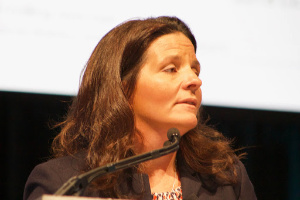
Equinor is perhaps better known for its North Sea exploration. But here it is, in the heart of Appalachia—the Utica, in particular.
“The Appalachia Basin has become the cornerstone of Equinor’s portfolio in the unconventional business,” Baird said. Equinor also holds positions in the Williston Basin, Eagle Ford and Louisiana Austin Chalk. Internationally, the company holds unconventional positions in Turkey and Argentina.
What started as a non-operated joint venture in 2008 continued with an acquisition of its operated portfolio in 2012. Equinor’s footprint in Appalachia now consists of non-operated positions in West Virginia of about 115,000 net acres and 105,000 non-operated net acres in Pennsylvania. Its operated position is in Ohio, consisting of 27,000 net acres in Monroe County.
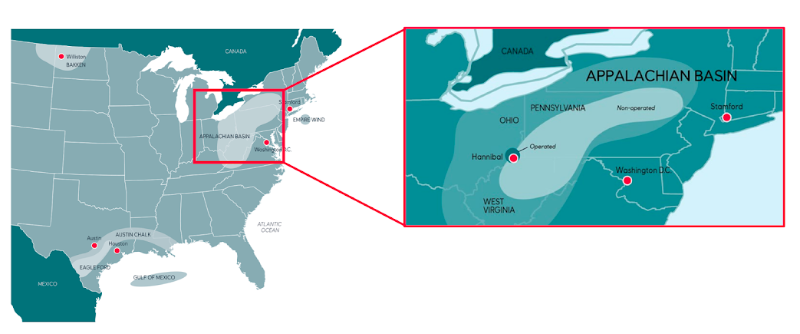
Baird said Equinor emphasizes high value for its wells. “It’s easy to be in unconventionals and talk about volume, but we want to talk about value,” she said. “We realize that margin businesses must be profitable and competitive at all times. It is fundamental for value creation.”
To that end, Baird said the company focuses on improving its efficiency in the Appalachian Basin. Its aim is to reduce unit coast and increase asset production,” she said.
Equinor has shown success. Over the last three years, the company has increased its production by more than 40%, Baird said.
“It’s been quite a journey. We’ve seen quite a few changes in Ohio over the last few years,” she said. “We’ve increased our production five-fold when you compare it to what we’ve produced in 2018 to 2016.”
At the end of 2018, Equinor had 33 producing wells from its operated position—24 in the Utica and nine legacy Marcellus wells.
“What makes me really excited is that we have one well that actually sits—from a 12-month production perspective—in the top 20 Utica wells that have been drilled since the inception of the play in Ohio, West Virginia and Pennsylvania.” It had a cumulative 12-month production of 7.5 Bcf.
Baird revealed that although Equinor’s operation in Ohio has been focused on the Utica, it is actively testing the Marcellus in Ohio. The company drilled a grassroots Marcellus well in 2018. The lateral length was about 14,000 ft.

Is the testing of the Marcellus in Ohio a precursor of things to come for the company?
“2019 and beyond is an exciting time for us at Equinor,” Baird said.
The grassroots Marcellus well has now had active completion operations since the beginning of 2019, Baird confirmed.
“We had the opportunity to complete three [stepout] wells on the pad, and it means when we actually turn this pad to production toward the end of the year it will be our first fully co-developed Marcellus and Utica pad in Ohio,” she said.
Baird said Equinor expects to put four new Utica wells into production on the pad, four modern-completion Marcellus wells, one legacy Utica well and two additional Marcellus-Utica legacy wells for a total well count of 11.
Baird also said the company is seeking to cut its costs through use of longer laterals in 2019.
“Our position in Ohio allows us—with our development plan—for 25% of our future remaining Utica wells to have lateral lengths over 18,000 ft. This allows us to develop our footprint with fewer wells,” she said.
Baird also addressed the company’s low-carbon priorities. The name change itself was intended to emphasize its low-carbon priorities. Equinor’s home country recently announced its sovereign wealth fund—the world’s largest—would divest from oil and gas exploration.
“It is our ambition to be a leading company in low-carbon oil and gas production,” Baird told the audience made up of mostly oil and gas executives. “Within Appalachia, we work to reduce sources of emissions by looking at process optimization to manage disruption in our production operations.”
She also pointed to the use of drones to conduct methane and CO2 baseline surveys and remote leak detection.
Len Vermillion can be reached at lvermillion@hartenergy.com.
Recommended Reading
Apollo Buys Out New Fortress Energy’s 20% Stake in LNG Firm Energos
2024-02-15 - New Fortress Energy will sell its 20% stake in Energos Infrastructure, created by the company and Apollo, but maintain charters with LNG vessels.
Summit Midstream Sells Utica Interests to MPLX for $625MM
2024-03-22 - Summit Midstream is selling Utica assets to MPLX, which include a natural gas and condensate pipeline network and storage.
Enbridge Sells Off NGL Pipeline, Assets to Pembina for $2.9B
2024-04-01 - With its deal to buy Enbridge’s NGL assets closed, Canada's Pembina Pipeline raised EBITDA guidance for 2024.
Hess Midstream Announces 10 Million Share Secondary Offering
2024-02-07 - Global Infrastructure Partners, a Hess Midstream affiliate, will act as the selling shareholder and Hess Midstream will not receive proceeds from the public offering of shares.
Venture Global Acquires Nine LNG-powered Vessels
2024-03-18 - Venture Global plans to deliver the vessels, which are currently under construction in South Korea, starting later this year.


